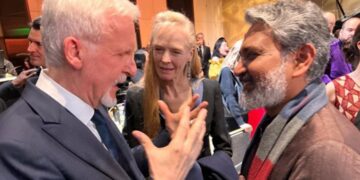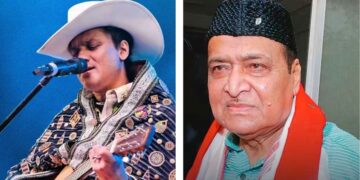The sudden demise of the youth icon Zubeen Garg at Singapore on September 19 under suspicious circumstances, explode in social media like a hurricane mobilizing all sections of people of Assam irrespective of caste, creed and religion to pay homage to the departed soul and also seek justice for the maestro.
In the melee of social media posts, Palme Borthakur’s (Sister of Zubeen Garg) research paper on “Modern Music in Guwahati: A Study of Cultural Fusion and Diffusion” has also come up for intense debate.
Zubeen, being a music maestro and his acceptance all throughout India and abroad opened the floodgates of the evolving discipline of musical geography, an area of study that is still relatively young but immensely powerful in shaping our understanding of how cultures interact.
Her work stands as a bridge between academic insight and lived experience, examining how urban environments like Guwahati act as crucibles where tradition and modernity fuse into new musical forms.
Musical geography, in its essence, examines the spatial properties of sound. It studies how landscapes influence creativity, how communities define themselves through music, and how melodies migrate, evolve, and root themselves in new soils.
Originating in the 1970s with pioneering efforts to trace musicians’ origins and performance spaces, the discipline has grown to cover an expansive range of themes.
Today, it includes the study of migration and diaspora music, the symbolic power of sound in place-making, the economic and political dimensions of the music industry, and the deep interconnections between natural environments and the sounds that emerge from them.
What makes this field compelling is that it does not restrict itself to narrow academic confines. Rather, it draws from anthropology, history, cultural studies, environmental science, and increasingly digital technologies, to map the lived experiences of people through music.
The rise of projects such as the Musical Geography Project at St. Olaf College, Northfield, Minnesota, USA and UNESCO’s extensive cataloguing of intangible musical heritage reveals the field’s growing international relevance.
From Paris in 1924 to the Silk Road Atlas, scholars have used maps, sound archives, and interactive databases to trace the journeys of instruments, rhythms, and traditions.
These endeavours show that music is never static—it is always on the move, adapting to new terrains, absorbing influences, and in turn, shaping identities and communities.
Palme Borthakur’s focus on Guwahati provides a striking regional example of this larger truth. The city, situated on the banks of the mighty Brahmaputra, is more than a geographical space; it is a cultural confluence where folk traditions meet Bollywood tunes, Western instruments blend with classical ragas, and youthful experimentation gives rise to hybrid genres.
This fusion is not a dilution of heritage but a dynamic reinvention that allows traditions to survive in new forms. Her research reveals that the urban soundscape of Guwahati is simultaneously rooted in Assam’s folk and classical heritage while also being open to global rhythms, creating a living laboratory for cultural diffusion.
Globally, the discipline of musical geography has gained further impetus from technological innovation. Digital mapping and sonic heritage projects have made it possible to re-experience spaces through sound, preserving intangible cultures while giving them new life in digital form.
The Sonic Heritage initiative, for example, presents sounds of UNESCO World Heritage sites reimagined by artists worldwide, while platforms like Cities and Memory assemble vast libraries of soundscapes, from the chants of temples to the hum of modern cities.
These efforts highlight how the sounds of spaces are as important as their sights, and how they carry stories, identities, and emotions that written history often overlooks.
At the same time, musical geography is deeply concerned with questions of identity and unity. Music, more than any other art form, has the power to transcend religious, ethnic, and linguistic divisions.
Festivals such as Assam’s Bihu or Kerala’s temple music traditions bring together communities in collective joy, creating temporary spaces where differences dissolve into shared rhythm.
Research shows that music venues often function as “third spaces,” not just centres of entertainment but also of social interaction and bonding, particularly in urban environments where fragmentation and alienation are common.
These insights help explain why music often becomes the heartbeat of movements for social cohesion, protest, or cultural revival. The situation in the wake of Zubeen’s death is an eloquent testimony to the above contention.
The influence of geography on music also extends to environmental and climatic contexts. The seasonal ragas of Indian classical music, inspired by monsoons, summers, and autumns, exemplify how natural cycles find resonance in sound structures. Mountain ranges inspire their own folk forms, for instance, Zubeen identifying himself as Kanchenjunga, while coastal rhythms echo the pulse of the sea.
Even the instruments themselves—wood from particular trees, strings from specific resources reflect the intimate dialogue between geography and music. In this way, the land speaks through sound, and communities encode their relationship with nature into melody and rhythm.
As globalization accelerates, the challenges for musical geography multiply. Cultural fusion is creating new global genres such as Afrobeat, but this raises questions about authenticity, preservation, and the pressures of commercialization.
Simultaneously, climate change threatens the ecological bases of many traditional instruments and practices, compelling researchers and communities to find adaptive strategies to preserve their musical heritage.
Yet even amidst these challenges, the discipline thrives on its interdisciplinary strength, incorporating insights from digital humanities, urban planning, and cultural policy to navigate the future.
The story of Assam’s most beloved music icon, Zubeen Garg, provides a poignant human dimension to this narrative. His music, infused with Assamese soul yet resonant with universal appeal, crossed borders of language and culture to unite people in shared emotion.
When he passed away in Singapore, the shockwaves were felt across Assam and beyond, bringing together communities across divides in collective mourning. In that moment, music embodied its deepest power—to unite, to heal, and to remind people of their common humanity.
His sister, Palme Borthakur, through her academic work, offers the theoretical framework to understand this phenomenon. Her research demonstrates how music creates what might be called an emotional geography—an invisible landscape of shared feeling that binds diverse people together across boundaries.
In the final analysis, musical geography teaches us that while nations may be divided by mountains, rivers, or politics, melodies flow freely across these barriers, carrying with them the essence of human experience.
It reveals that the geography of sound is not merely a subject of academic study but a lived reality that shapes identities, builds communities, and fosters understanding.
Music is at once local and global, rooted in place yet open to all, deeply personal yet universally shared.
Like the Brahmaputra that flows through Assam, music too carries with it the hopes, dreams, and stories of countless people. It gathers small tributaries from diverse cultures, weaving them into one grand current that sustains life and memory.
And just as the Brahmaputra does not discriminate in its flow, embracing all lands along its course, so too does music embrace humanity in its entirety, reminding us that in the vast river of human experience, every voice, every note, and every rhythm belongs to a larger, timeless symphony that echoes across borders and generations.















